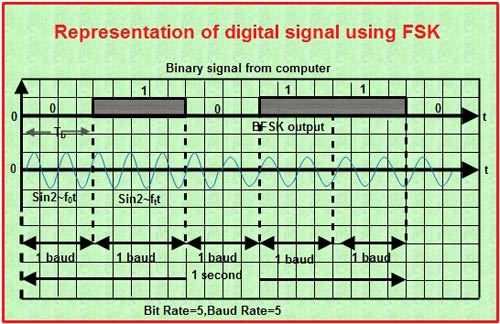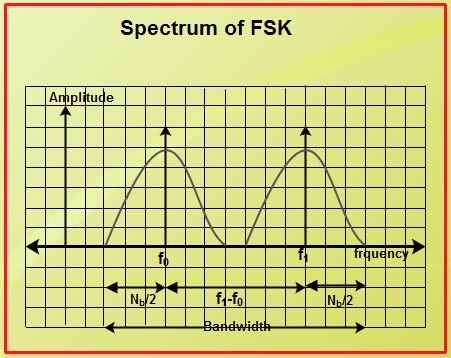In “frequency shift keying (FSK)”, the frequency of a sinusoidal carrier is shifted between two discrete values. One of these frequencies (f1) represents a binary “1” and the other value (f0) represents a binary “0”. The representation of digital data using FSK is as shown in Fig. Note that there is no change in the amplitude of the carrier.

Bandwidth for FSK in terms of baud rate
• For FSK also bit rate is equal to baud rate.
• We can imagine the FSK spectrum to be a combination of two ASK spectrums centered at frequencies fH and fL.

From Fig. the expression for bandwidth is given by
BW = Nb + (f1 – f0) + Nb = (f1 – f0) + Nb
2 2
Where Nb = baud rate = bit rate = fb
• Minimum bandwidth will correspond to the situation in which (f1 – f0) = Nb
BW (min) = Nb + Nb = 2 Nb
Advantages of FSK
• FSK is relatively easy to implement.
• It has better noise immunity than ASK. Therefore the probability of error free reception of data is high.
Disadvantages of FSK
1. The major disadvantage is its high bandwidth requirement as’ discussed earlier.
2. Therefore FSK is extensively used in low speed modems having bit rates below 1200 bits/sec.
3. The FSK is not preferred for the high speed modems because with increase in speed, the bit rate increases.
4. This increases the channel bandwidth required to transmit the FSK signal.
5. As the telephone lines have a very low bandwidth, it is not possible to satisfy the bandwidth requirement of FSK at higher speed. Therefore FSK is preferred only for the low speed modems.
 Dinesh Thakur holds an B.C.A, MCDBA, MCSD certifications. Dinesh authors the hugely popular
Dinesh Thakur holds an B.C.A, MCDBA, MCSD certifications. Dinesh authors the hugely popular